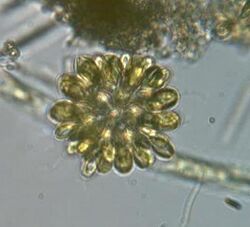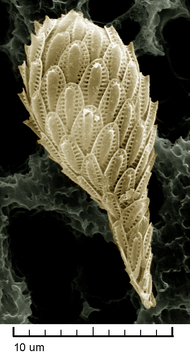Biology:Synurid
| Synurids | |
|---|---|

| |
| A colony of Synura sp. | |
| Scientific classification | |
| Domain: | Eukaryota |
| Clade: | Diaphoretickes |
| Clade: | SAR |
| Clade: | Stramenopiles |
| Phylum: | Gyrista |
| Subphylum: | Ochrophytina |
| Class: | Chrysophyceae |
| Order: | Synurales Andersen, 1987 |
| Genera[1] | |
| |
The synurids (order Synurales) are a small group of heterokont algae, found mostly in freshwater environments, characterized by cells covered in silica scales.[2]
Characteristics

They are covered in silicate scales and spines. In Synura, these are formed on the surface of the chloroplasts,[3] two of which are usually present, but sometimes only one divided into two lobes is seen. The cells have two heterokont flagella, inserted parallel to one another at the anterior, whose ultrastructure is a distinguishing characteristic of the group. Both asexual and isogamous sexual reproduction occur.
Genera
Two major genera are included here, divided into species mainly based on the structure of the scales.
- Mallomonas species are free-living individual cells, usually 50–100 μm in length. They have ornate scales and generally long spines.
- Synura species occur as spherical colonies, with the cells oriented so that the flagella point outwards, each usually around 30 μm in length. The colonies are globular, rather than hollow, and spines are short if at all present.
Both are common plankton in lakes and ponds. In high concentrations, they dye the water yellow, and produce a distinctive odour.
To reproduce the parent cell splits into two daughter cells which get half of the parent cells scales. The new cells can regrow the scales and grow back into their original form.
History
The genus Synura was proposed in 1834 by the German microscopist Christian Gottfried Ehrenberg (1795–1876).[4]
The synurids were originally included among the golden algae in the order Ochromonadales as the family Mallomonadaceae or as the family Synuraceae . They were formally defined as a separate group by Andersen in 1987, who placed them in their own class Synurophyceae, based on an earlier approach of more narrowly defining major lineages of chrysophyte algae by British phycologist David Hibberd.[5][6]
The Chrysophyceae and Synurophyceae are currently recognized as closely related taxa within the Stramenopiles.[7][8] Present classifications include the synurids as an order (Synurales) within Chrysophyceae.[2][9]
References
- ↑ Škaloud, Pavel; Kristiansen, Jørgen; Škaloudová, Magda (July 2013). "Developments in the taxonomy of silica-scaled chrysophytes – from morphological and ultrastructural to molecular approaches". Nordic Journal of Botany 31 (4): 385–402. August 2013. doi:10.1111/j.1756-1051.2013.00119.x.
- ↑ 2.0 2.1 "Morphological delineation and distribution patterns of four newly described species within the Synura petersenii species complex (Chrysophyceae, Stramenopiles)". European Journal of Phycology 49 (2): 213–229. 2014. doi:10.1080/09670262.2014.905710.
- ↑ Barry S.C. Leadbeater (1990), "Ultrastructure and assembly of the scale case in Synura (Synurophyceae Andersen)", British Phycological Journal 25 (2): 117–132, doi:10.1080/00071619000650111
- ↑ See:
- Ehrenberg (1833). "Dritter Beitrag zur Erkenntniss grosser Organisation in der Richtung des kleinsten Raumes" (in de). Abhandlungen der Königlichen Akademie der Wissenschaften zu Berlin [Treatises of the Royal Academy of Sciences in Berlin]: 145–336. https://www.biodiversitylibrary.org/item/93805#page/181/mode/1up. From p. 281: Ehrenberg created a new family, Volvocina, " ... wozu ich die vier neuen Gattungen Chlamidomonas, Syncrypta, Synura, und Uroglena stelle." ( ... into which I place the four new genera Chlamidomonas, Syncrypta, Synura, and Uroglena.) [Note: According to p. 145, Ehrenberg's paper was first presented in 1832, revised somewhat, and published in 1834.]
- See also: AlgaeBase: Synura Ehrenberg, 1834
- ↑ Hibberd, D. J. (1976). "The ultrastructure and taxonomy of the Chrysophyceae and Prymnesiophyceae (Haptophyceae): A survey with some new observations on the ultrastructure of the Chrysophyceae". Botanical Journal of the Linnean Society 72 (2): 55–80. doi:10.1111/j.1095-8339.1976.tb01352.x.
- ↑ Hibberd, David J. (1979). "The structure and phylogenetic significance of the flagellar transition region in the chlorophyll c-containing algae". Biosystems 11 (4): 243–261. doi:10.1016/0303-2647(79)90025-X. PMID 396946.
- ↑ "Multigene Evidence for the Placement of a Heterotrophic Amoeboid Lineage Leukarachnion sp. among Photosynthetic Stramenopiles". Protist 160 (3): 376–85. March 2009. doi:10.1016/j.protis.2009.01.001. PMID 19282238.
- ↑ W. Vyverman; G. Cronberg (March 1993). "Scale bearing chrysophytes from Papua New Guinea". Nordic Journal of Botany 13 (1): 111–20. doi:10.1111/j.1756-1051.1993.tb00022.x.
- ↑ Cavalier-Smith, Thomas (2017). "Kingdom Chromista and its eight phyla: a new synthesis emphasising periplastid protein targeting, cytoskeletal and periplastid evolution, and ancient divergences". Protoplasma 255 (1): 297–357. doi:10.1007/s00709-017-1147-3. PMID 28875267.
External links
Wikidata ☰ Q948998 entry
 |

